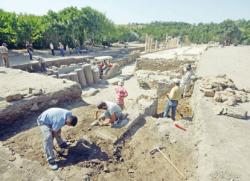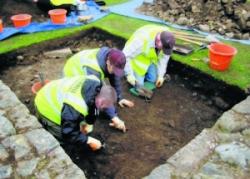- 11 AOÛT
- INDI-UNI : 
PRE-INSCRIPTION : 15 Juin – 15 Août
PRE-REGISTRATION: June 15th - August 15th
- FRANCE - Lézignan-Corbières - Une nouvelle campagne de fouilles s’est tenue dernièrement sur le site paléontologique et archéologique de la carrière. Les chercheurs bénévoles ont mis au jour de nouveaux outils attestant de la présence humaine sur le site il y a 1 570 000 ans. Les galets taillés déjà trouvés sur le site attestaient une présence humaine. Les os fracturés mis au jour confirment cette hypothèse : ils auraient été cassés pour récupérer la moelle. Après la certification des découvertes lézignannaises par Yves Coppens, Henry de Lumley a validé à son tour le matériel trouvé. Le découvreur de l’homme de Tautavel propose un projet englobant la préhistoire du Bas-Languedoc de la grotte de l’Hortus jusqu’à Tautavel en passant par Lézignan. L’inrap prendrait en charge les fouilles en lieu et place du service de recherches archéologiques du Languedoc-Roussillon, pour trois ans.
http://www.midilibre.fr/2011/08/11/dma-nouvelle-campagne-de-fouilles-archeologiques,370076.php
- TURQUIE – Laodicea - In a church in Laodicea 1,600-year-old mosaics were discovered, which are believed to symbolically depict God’s eyes. The director of the excavation at Laodicea, Professor Celal Şimşek, said the mosaic was unearthed in one of three churches that is currently being restored and that it was believed to depict God’s eyes, further adding: “In the excavation we are currently undertaking in Denizli’s Eskihisar district, every new day treats us to valuable historical discoveries. This one, we believe, is a particularly important find.”
http://www.todayszaman.com/news-253359-denizli-strikes-gold-with-archaeological-discoveries.html
- TURQUIE – Tabae - Excavations in the scenic rural district of Kale, where the castle of Tabae, believed to have been built by the followers of Alexander the Great, is located, happened upon two Roman-period sculptures believed to be of Aphrodite. Speaking at a press conference about the discovery of the Aphrodite sculptures, the director of the excavation board at Kale, Professor Bozkurt Ersoy, said the relics were found at an excavation around a Roman cistern at Tabae, where pieces of bronze and marble sculpture were previously discovered. Emphasizing Tabae’s importance in the Roman era, Ersoy said: “These are very valuable discoveries. Sculptures of Aphrodite are rare and these are unrivalled artifacts. For one of the pieces we have only as yet discovered the head piece; this is a sculpture from the early Hellenistic period, which we believe dates back to the second half of the fourth century B.C. At this stage, however, there is still a possibility that it could be a copy from the Roman period. The other sculpture, which has the head and body intact, we believe it comes from the third century A.D.”
http://www.todayszaman.com/news-253359-denizli-strikes-gold-with-archaeological-discoveries.html
- ESTONIE – Salme - The ancient ship burial site in Salme on the island of Saaremaa still has some surprises in store. The archeological excavations in Salme, soon to be completed, have yielded evidence that the ship that had been buried with 35 warriors and nobles had a keel, which in turn leads to the conclusion that it used sails. This represents the earliest known use of sails on a vessel in the Baltic Sea region. "One piece of new information that we have been anticipating since winter was still to be found - namely, confirmation of whether it was a sailing ship or not. Now we have evidence that it used sails," said archeologist Jüri Peets of Tallinn University. Peets called this discovery the cherry on top of the cake that was the nearly two-year-long archeological dig. "It is thought that sails were first introduced in the North Sea and Baltic Sea region at about 700 A.D., which is the conventional date. Our ship dates from the year 750. The ship from the year 700 was from the North Sea region, near Norway. However, here in the Baltic Sea region, this is without a doubt the oldest sailing ship that has been found," said Peets. In addition to the discovery of the keel, the irregular rows of strong rivets found on the bottom of the vessel also prove that the ship used sails. Maritime archaeologist Vello Mäss confirmed that the Salme ship was without a doubt a warship that used sails. Although sails had been long in use in the Mediterranean Sea region, it was the Norwegians who first started using them in the North Sea region. Mäss also suggested that perhaps two separate war parties on two different ships had met in Salme centuries ago. Such hypotheses concerning the Salme ship burial site are sure to keep the scientists busy for years to come.
http://news.err.ee/culture/00225c4a-581e-4ee0-b87c-6fda799a5476
- TURQUIE –  Stratonikeia - Researchers working at Stratonikeia in the southwestern province of Muğla have discovered a 1,675-year-old church following recent excavations, according to the leader of the dig. “We found a church made in 325 B.C., and we discovered that this church was destroyed and made again from the ruins,” said Bilal Söğüt, a scholar at Pamukkale University Archaeology Department in the nearby province of Denizli. “We plan to reveal the details of the church as soon as possible and then we will open it to public view.” In addition to the church, recent excavations in the area have unearthed a number of archaeological treasures, including a 2,500-year-old sewage system, an ancient theater and ancient houses. The church, which lies on the right side of the entrance to the ancient city, is one of the oldest in the area.
Stratonikeia - Researchers working at Stratonikeia in the southwestern province of Muğla have discovered a 1,675-year-old church following recent excavations, according to the leader of the dig. “We found a church made in 325 B.C., and we discovered that this church was destroyed and made again from the ruins,” said Bilal Söğüt, a scholar at Pamukkale University Archaeology Department in the nearby province of Denizli. “We plan to reveal the details of the church as soon as possible and then we will open it to public view.” In addition to the church, recent excavations in the area have unearthed a number of archaeological treasures, including a 2,500-year-old sewage system, an ancient theater and ancient houses. The church, which lies on the right side of the entrance to the ancient city, is one of the oldest in the area.
http://www.hurriyetdailynews.com/n.php?n=centuries-old-church-unearthed-in-mugla-2011-08-10
- SRI LANKA – Polonnaruwa - Sri Lanka Archaeology Department says that the island in the middle of the Parakrama Samudraya reservoir of historic Polonnaruwa town has been destroyed by fire. The main monuments in the island are the ruins of an ancient palace called Sita Palace. It is believed that the palace was used by King Parakramabahu, the most powerful king in one time capital of the island, as his leisure residence in 13th century.
http://www.colombopage.com/archive_11A/Aug11_1313038048KA.php
- PAKISTAN – Chiniot - Remains of a fourth century AD Buddhist stupa and monastery have been found on the foothills of Chiniot. The area where these archeological ruins are found was also known as “Punj Peer”. Some graves, walls of rooms, meditation cells built with stones, terracotta bricks, animal bones, and pottery has been found at the surface of site. These remains, scattered over about nine acres, were discovered by a Chiniot-based NGO, Lok Baithak, the officials said. The NGO has also handed over a gold coin, said to be of late Kushana King 2nd’s period, to the archaeology department to put it on display in the museum. It was found from a mound in the recently discovered area. The officials are of the view that the site may be the ruins of the lost OJAN or OJAIAN, a Buddhist university which was contemporary with Julian University, Texila, as mentioned by different historians. Chiniot is a historically significant area with rich archaeological evidence dating back to Greek-Mauryan period. It has remained an important city during the reigns of Mughal emperors Jehangir and Shah Jahan. The ancient history of Chiniot has been explored and reported by different historians. According to these historians, the pre-historic rock carvings of Chenab area near Chiniot give a clue to the ancient history of this place. To the west of Chenab River are the 700-foot high hills of Chenab Nagar in front of Rabwah. These hills are part of Kirana hills which are 10 million years old. Below these hills are the settlements of Kushan-Hindu Shahi period.
http://www.dawn.com/2011/08/11/buddhist-relics-found-near-chiniot.html
- ROYAUME UNI –  Kilwinning Abbey - Archaeologists will launch the second phase of the Kilwinning Abbey dig this month as they look to uncover clues to the town's medieval past. The Kilwinning Community Archaeology Project will begin excavations on Wednesday, August 17, as organisers begin to trace the historical origins and evolution of the burgh. Last year, the project uncovered a number of artefacts within the Abbey grounds, however, this season's dig will branch out to the surrounding areas.
Kilwinning Abbey - Archaeologists will launch the second phase of the Kilwinning Abbey dig this month as they look to uncover clues to the town's medieval past. The Kilwinning Community Archaeology Project will begin excavations on Wednesday, August 17, as organisers begin to trace the historical origins and evolution of the burgh. Last year, the project uncovered a number of artefacts within the Abbey grounds, however, this season's dig will branch out to the surrounding areas.
http://www.ardrossanherald.com/news/garnockvalley/articles/2011/08/11/415989-second-phase-of-dig-is-beginning/
- USA – Nevada City - This year, teachers from Browning to Bozeman worked on the Richards cabin, one of about 14 original Nevada City buildings. The cabin was built in 1864 by the Richards brothers, two miners who brought their wives, children and mother to Alder Gulch in the hopes of striking it rich. The Richards were among 10,000 people who flocked to the gulch in Montana’s biggest gold rush. Before long, the gold in Nevada City was panned out. The place was nearly empty by 1876, according to the Montana Heritage Commission. The Richards left in 1868, but they left behind a wealth of objects to tell the story of their lives.
http://www.bozemandailychronicle.com/news/education/article_3c4307cc-c3b1-11e0-b27a-001cc4c03286.html